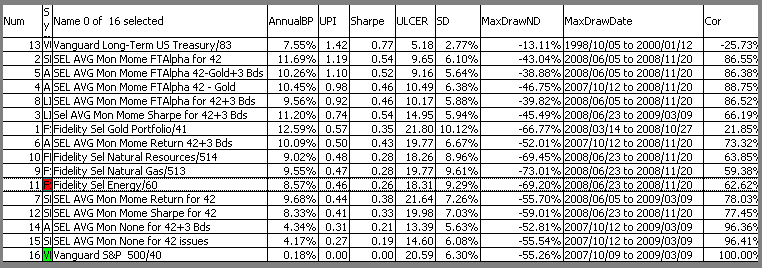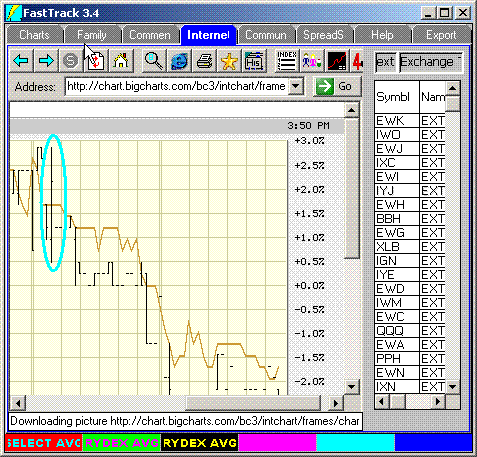Trading Sector Funds using the Momentum Model
Post on: 11 Июль, 2015 No Comment

Trading Sector Mutual Funds using
the FT4Web Momentum Model
Updated 04/08/14
This article discusses Momentum modeling among many sector funds. Momentum’s dynamic allocation trading will often produce more return, with less risk, when compared to static allocations.
There is another interesting short article that compares dynamic to static allocation which describes an effective simpler strategy than what is discussed in this article.
There is a related article which deals with Managing Money using the FTAlpha Momentum modeling .
Fidelity and ETFs- YES
The first question is,
Which group of sector funds should I trade?!
The Fidelity Selects well known, well-managed sector funds. FastTrack users have long been holders of Fidelity funds.
- Fidelity has consistently and actively managed funds with reasonable quality, diversity, cost, and trading limitations.
- These funds have a lot of history for backtesting.
- Fidelity rarely discontinues funds for poor performance, reducing survivor bias (Backtesting looks great when all the dog funds have been discontinued)
On October 2003, Fidelity eliminated the 3% front-end load for its SELECT sector funds to better compete with Exchange Traded Funds and other sector funds. This opened a broader range of sector trading opportunities. The remainder of this article discusses the trading of the Selects. However, the same principles apply to all funds.
Improving on the Selects
The Selects are notably missing international funds, bond funds, and Realty funds. Here are some good potential funds to include:
- VUSTX/TLT, US long Bonds
- CSRSX/ICF, realty funds
- EEM/FEMKX, emerging markets
- FLPSX, low priced stock
- FFXSX/TUZ,or SHY, VGSH, BSV Short Bonds
The listed open-end funds above have many years of history. The ETFS are highly correlated to those open-end funds. Use the long history funds for proof of concept, but trade the ETFs.
The easy way to start back testing sector funds
- Right-click in the center of the chart
- Choose Load .
- Choose Charts .
- Choose Tradable_Sector_Funds.CDF
- Click the word TotReturn label in the upper left to display the Chart Label

What You See is.
Chart 1:
Chart 1’s Select AVG, red line, above is a monthly, equal assets, rebalanced average of all the Selects (including money market). Note,
- Combining all these US sector funds into a single line produced a red line highly correlated to the S&P 500 (the green line).
- A Red Cor= over 90% indicates that the red and green lines almost always move in the same direction.
- The Red and Green SD= values measure volatility. In this case the red line is slightly less volatile than the green line. a clear case of more return with less risk .
The message to the investor is that Fidelity Selects are well-managed, provide good risk-adjusted return, and are built on 500 stocks of S&P.
Note: This AVG includes FNINX and FSPFX which were discontinued on 6/17/2009. This avoids survivor bias caused by removing these dogs. In fact, the annualized return between 6/17/2009-1/10/2011 did improve by 5.1% annually (not shown).
The Momentum Model
Sell the losers. Let the Winners ride .
Chart 2’s terrific Select AVG red line is created by selling the lowest ranking Select funds at the end of each month, and then buying the highest ranking funds on the first of the month. This differs from Chart 1 which simply held all funds in an equal amount rebalanced monthly.
Chart 2’s model only sells 25% of assets each month, and reinvests in the top 10% (by count of funds in the family). This example was ranked by return (gain/loss n the last calendar month)
When you compute an AVG line, you can see what trading took place. Start your favorite text editor like Notepad. Open the file named:
C:FTFT4WINTEMPREBALANCE.LOG
The following is an abbreviated list of trades that were performed to generate Chart 1’s red line.
Chart 2:
Starting with Chart 1 displayed as discussed above.
- Right-click in the center of the chart and select Appearance.
- In the second column. Select Rank by Return.
- Click the Draw Chart button.
- Right-Click on the red ColorBar cell and select Recompute AVG
Chart 2’s Reblance.LOG
A Rebalance.log file is created each time you compute an AVG line. It shows the trading that produced Chart 2’s red line.
Rebalance.Log’s top line shows that starting at 9/1/88, $100,000 in assets was divided equally among the 30 Select funds which existed at that time. These is no magic in this starting strategy. We will discuss how real people start using the model further down. At the end of the month, 9/30/88, the model sells all or part of the worst funds until $26,025.14 of assets are in cash (25% of the end of month assets). The term investable refers to issues which existed and had assets.
These assets are then placed in equal dollar amounts into the top 10%, by count, of funds. Top funds are those which had the highest return during September 1988.
In the beginning.
SELECT Monthly Momentum by Return Rebalance Log on 01-10-2011 at 17:55:00
09/01/1988 Divided $100,000.00 between 30 issues, each getting $3,333.33
09/01/1988 All Asset Total= $99,999.999
09/30/1988 Sold: $ 3,209.42 of FSESX
09/30/1988 Sold: $ 3,218.76 of FSAGX
09/30/1988 Sold: $ 3,319.79 of FSENX
09/30/1988 Sold: $ 3,338.44 of FSDPX














